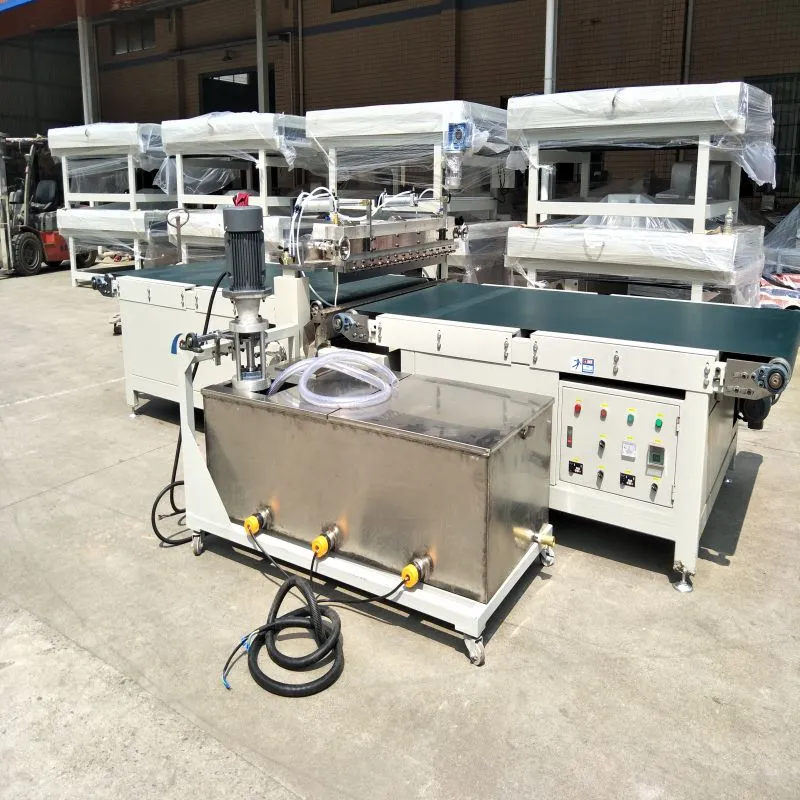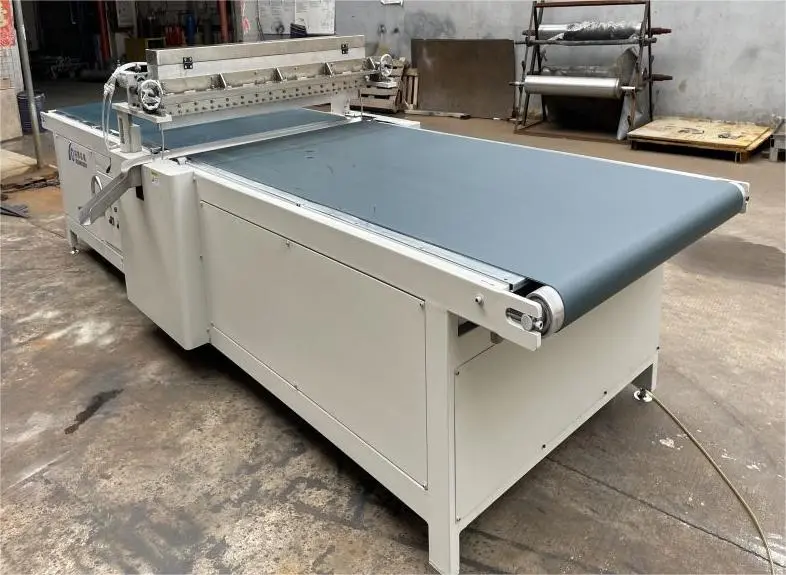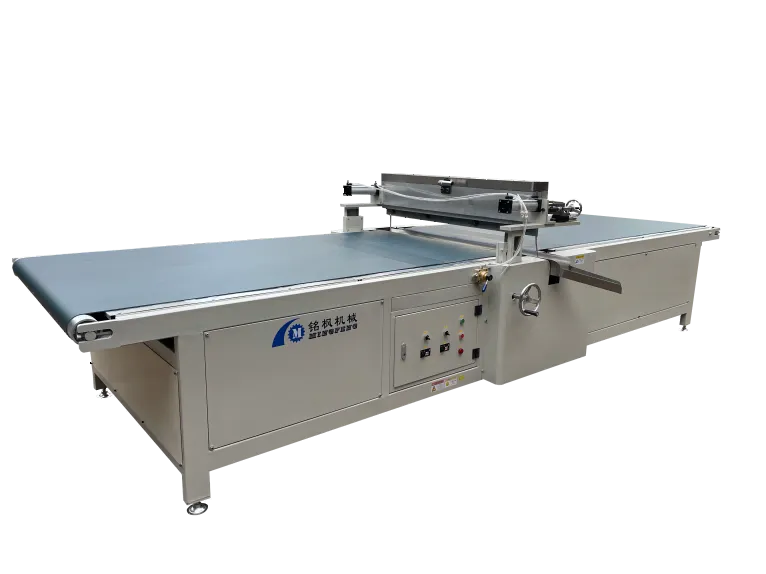In the field of surface treatment and coating technology, the term UV curtain coating machine is a frequently used term for equipment.
However, many people, upon first hearing the term "curtain-type," mistakenly believe it refers to a machine used to process curtains. In fact, it is an industrial surface coating machine and has nothing to do with traditional fabric curtains.
This article will provide an in-depth explanation of the process, including its definition, operating principle, structural composition, coating process, advantages and characteristics, application scope, and key process control points, to comprehensively answer the question, "Is a UV curtain coating machine used for curtains?"
What is a UV curtain coating machine?
A UV curtain coating machine is a type of equipment specifically designed for industrial surface coating. It forms a "curtain" of liquid UV-curable coating, evenly applies it to the substrate surface under gravity, and then rapidly cures it using ultraviolet light, achieving a high-quality surface coating.
The "curtain-type" term here refers to the liquid coating curtain, not the curtain or fabric product itself. UV refers to ultraviolet curing technology, which instantly cures the coating under UV light, creating a hard, wear-resistant coating. Therefore, a UV curtain coating machine is not a device for curtains, but rather a high-precision, high-efficiency, and environmentally friendly industrial coating machine. Understanding this is key to dispelling misunderstandings.

How does a UV curtain coating machine work?
1. Paint Supply and Circulation System
The paint is stored in a dedicated tank and delivered to the coating nozzle by a circulation pump. The circulation system maintains a constant paint flow and pressure, preventing uneven coating thickness caused by flow fluctuations. Modern equipment is often equipped with precision filtration to ensure that the paint is free of impurities during circulation, thereby ensuring coating quality.
2. Liquid Curtain Formation
After the paint flows from the nozzle, gravity forms a continuous, uniform liquid curtain. The curtain width, thickness, and flow rate are precisely controlled by the machine design to cover the entire substrate surface. The resulting liquid curtain, similar to a "water curtain," ensures uniform, smooth, and bubble-free coating.
3. Substrate Passes Through the Coating Area
The substrate being processed (wood, plastic, metal, cardboard, or glass) passes through the liquid curtain area via a conveyor system. The substrate surface is instantly and evenly coated with a layer of liquid coating, eliminating the streaks and unevenness that can occur with traditional roller coaters.
4. Paint Recovery System
Excess paint not absorbed by the substrate is collected in a recovery tank, filtered, and then returned to the reservoir, enabling paint recycling and significantly reducing material waste.
5. UV Curing
The coated substrate immediately enters the UV curing section. A UV light source irradiates the substrate with high-intensity ultraviolet light, triggering a reaction between the photoinitiators in the coating and curing the coating within seconds. The resulting coating is hard, wear-resistant, and has a high gloss finish that is both aesthetically pleasing and durable.
This operating principle demonstrates that a UV curtain coating machine is an industrial device that combines high-precision coating and rapid curing, unrelated to curtain fabric processing.

What are the structural components of a UV curtain coating machine?
A complete UV curtain coating machine consists of several key components, each of which is crucial to ensuring coating accuracy, efficiency, and stability:
• Paint reservoir: This is used to store UV coating and is typically equipped with a thermostat or agitator to maintain stable viscosity and fluidity.
• Circulation Pump and Liquid Supply System: A precision pump and piping system ensures a continuous and uniform supply of paint to the coating nozzle. The pump's flow rate and pressure are adjustable to meet varying coating thickness requirements.
• Curtain Nozzle: The core component of the coating machine, precisely designed to create a uniform liquid curtain. The nozzle's height, width, and paint flow rate determine coating thickness and uniformity.
• Conveyor: Conveyor systems, including chain, belt, or roller conveyors, ensure smooth, constant-speed movement of substrates through the coating area.
• Paint Recovery: Excess paint is collected in a recovery tank and filtered before recirculating the coating system, minimizing waste and ensuring cleanliness.
• UV Curing System: This system includes high-intensity UV lamps or LED-UV light sources, along with reflective panels, for rapid coating curing.
• Control System: Modern equipment is often equipped with a PLC and touchscreen, enabling automated and precise control of parameters such as coating speed, UV lamp power, and curtain height.
A detailed analysis of the structure reveals that the design and functional objectives of the UV curtain coating machine are unrelated to fabric curtains.
UV Curtain Coating Machine: What are the characteristics of this coating method?
1. Non-Contact Coating
A liquid curtain coats the substrate surface without the need for contact rollers or nozzles, eliminating scratches or unevenness caused by mechanical friction.
2. High Uniformity
Liquid curtains are inherently uniform, achieving a mirror-like coating effect. Compared to traditional roller or brush coating, coating streaks are significantly reduced.
3. Controllable Coating Thickness
By adjusting the paint flow rate, curtain height, and substrate transport speed, the coating thickness can be precisely controlled, typically ranging from tens to hundreds of microns.
4. High Efficiency and Environmental Protection
The paint recovery rate is high, and the UV curing process eliminates solvent volatilization, meeting modern industrial environmental protection requirements.
Therefore, the coating method used by UV curtain coating machines is completely independent of curtain fabrics; it is a high-precision coating technology for industrial panels and substrates.
Advantages and Features of UV Curtain Coating Machines
• Uniform and smooth coating: Liquid curtain coating ensures consistent thickness and a smooth, bubble-free surface.
• High Gloss: The coating can achieve a mirror-like gloss after UV curing.
• Strong wear resistance: High hardness, excellent scratch and abrasion resistance.
• Fast curing speed: Cures in seconds, improving production efficiency.
• Outstanding environmental performance: Solvent-free, low VOC emissions, meeting environmental standards.
• High paint utilization rate: Recycling reduces waste.
• Wide adaptability: Applicable to materials such as wood, glass, plastic, metal, and cardboard.
These advantages further demonstrate that the UV curtain coating machine is an industrial surface treatment device, not a tool for processing textiles or home furnishing products.

What are the applications of the UV curtain coating machine?
• Furniture industry: High-gloss protective coatings on wood surfaces such as solid wood boards, veneers, and density boards.
• Flooring industry: Wear-resistant coatings on wood floors and laminate floors to increase their lifespan and aesthetics.
• Glass industry: Transparent protective or decorative coatings on glass surfaces to increase hardness and gloss.
• Packaging industry: Coating paper and cardboard surfaces to improve print quality and wear resistance.
• Electronics industry: Coating plastic or metal casings to improve wear resistance and aesthetics.
As can be seen, UV curtain coating machines are suitable for hard materials such as sheet materials, glass, paper, metal, and plastic, rather than fabrics or curtains.
Key Process Control Points for UV Curtain Coating Machines
To fully utilize the capabilities of a UV curtain coating machine, the following process controls are essential:
• Paint viscosity adjustment: Excessively high viscosity will result in an uneven curtain; excessively low viscosity will cause sagging. Precise control is required according to process standards.
• Paint flow and pump pressure stability: Ensure a stable, uninterrupted liquid curtain to avoid fluctuations in coating thickness.
• Substrate surface preparation: The substrate surface should be flat, clean, and dust-free to ensure coating adhesion and gloss.
• Curtain height and conveyor speed matching: Excessively low height or excessively high speeds can affect coating thickness uniformity and require precise adjustment.
• UV curing energy control: Curing power and time must match the coating thickness and paint properties to ensure complete curing.
• Environmental control: Prevent dust and impurities from entering the coating area to ensure coating quality.
These control points ensure that the UV curtain coating machine achieves high-quality and efficient coating results during production.
The Difference Between a UV Curtain Coating Machine and Curtains
Comparison Items | UV curtain coating machine | Curtains |
Definition | Industrial coating equipment | Home Decor |
Blind Meaning | Liquid coating curtain | Fabrics, Textiles |
Application Targets | Wood, glass, metal, cardboard, plastic | Textile Fabrics |
| Function | Surface coating treatment | Light-blocking, aesthetic, decorative |
| Relevance | Unrelated | Unrelated |
The above comparison clearly demonstrates that UV curtain coating machines have nothing to do with curtains; they are specialized coating and curing equipment for the industrial sector.
How does XMF Machinery ensure high quality at a low price?
At XMF Machinery, we understand that buyers are looking for the perfect balance between high quality and low price. Our factory integrates advanced manufacturing technology with strict quality control, ensuring that every machine meets international standards. We are not only a manufacturer but also a company committed to providing affordable purchasing options, flexible quotes, and professional after-sales service for coating equipment.
